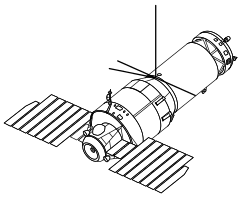Salyut 3
Salyut 3 was a space station in the Soviet Union's Almaz program. It was also known as OTS-2 and Almaz 2. The size and shape were similar to Salyut 1, but the rest of the design was very different. This was because it was part of the Almaz program instead of the Salyut program.[1] It was only named Salyut 3 to hide its real purpose. In reality it was a military station for spying on other countries.[5] Most details of it were not known until after the Cold War was over.[6][7]
 | |
| Station statistics | |
|---|---|
| COSPAR ID | |
| Call sign | Salyut 3 |
| Crew | 2 |
| Launch | 25 June 1974 04:15:00 UTC[1] |
| Launch pad | LC-81/23, Baikonur Cosmodrome, Soviet Union[1] |
| Reentry | 24 January 1975 |
| Mass | 18,900 kg (at launch)[2] |
| Length | 14.55 m[2] |
| Width | 4.15 m (maximum diameter)[2] |
| Pressurised volume | 90 m³[2] |
| Perigee | 219 kilometres (136 mi) (initial orbit)[3] |
| Apogee | 270 kilometres (170 mi) (initial orbit)[3] |
| Orbital inclination | 51.6 degrees[4] |
| Orbital period | 89.1 minutes[4] |
| Days in orbit | 213 days |
| Days occupied | 15 days |
| Statistics as of de-orbit and reentry | |
| Configuration | |
 Salyut 3 diagram | |
The station had living areas for cosmonauts, engines, and solar panels.[4] These were similar to other space stations. Due to its military nature, it also had some special equipment. There was a space telescope and several cameras, all for looking at the Earth. A small spacecraft called the Earth-return capsule stored film and could come back to Earth on its own.[1] It was also possible for cosmonauts to develop film on the station and send back the images using a TV system. Salyut 3 also had an onboard cannon (large gun), based on a design used on aircraft.[7]
Salyut 3 was launched into orbit on 25 June 1974 by a Proton rocket.[1] It stayed in space for 213 days before being burned up in the atmosphere. Starting on 4 July 1974 a crew of two cosmonauts stayed at the station for two weeks.[8] Then on 26 August 1974 a second crew arrived but could not connect to the station and so had to return to earth.[9] After this no other crews visited, but the station could do some tasks on its own. One was sending the Earth-return capsule back. The second was firing the cannon. This is the only time a gun has been fired in space.[6] A total of 20 rounds were fired in 3 bursts.[5][7]
On 24 January 1975 the station entered the atmosphere and burned up.[4] It was followed by Salyut 4 which was a civilian space station. The next Almaz station was Salyut 5.
References
- ↑ 1.0 1.1 1.2 1.3 1.4 Zak, Anatoly. "Salyut-3 (OPS-2) space station". RussianSpaceWeb.com. Retrieved 29 April 2021.
- ↑ 2.0 2.1 2.2 2.3 D.S.F. Portree (March 1995). "Mir Hardware Heritage" (PDF). NASA. Archived from the original (PDF) on 2009-08-03.
- ↑ 3.0 3.1 Peter Bond (20 June 2002). The continuing story of the International Space Station. Springer. p. 416. ISBN 1-85233-567-X.
- ↑ 4.0 4.1 4.2 4.3 "Salyut 3". NASA Space Science Data Coordinated Archive. NASA. Retrieved 29 April 2021.
- ↑ 5.0 5.1 Gallagher, Sean (17 November 2015). "Russian television reveals another secret: the Soviet space cannon" (in en-us). Ars Technica. https://arstechnica.com/information-technology/2015/11/russian-television-reveals-another-secret-the-soviet-space-cannon/. Retrieved 29 April 2021.
- ↑ 6.0 6.1 Ganninger, Daniel (7 June 2020). "The One and Only Time a Gun Has Been Fired in Space". Medium. Retrieved 29 April 2021.[dead link]
- ↑ 7.0 7.1 7.2 Zak, Anatoly (16 November 2015). "Here Is the Soviet Union's Secret Space Cannon". Popular Mechanics. https://www.popularmechanics.com/military/weapons/a18187/here-is-the-soviet-unions-secret-space-cannon/. Retrieved 29 April 2021.
- ↑ Wade, Mark. "Soyuz 14". Encyclopedia Astronautica. Archived from the original on 22 August 2009.
- ↑ Wade, Mark. "Soyuz 15". Encyclopedia Astronautica. Archived from the original on 8 January 2010.